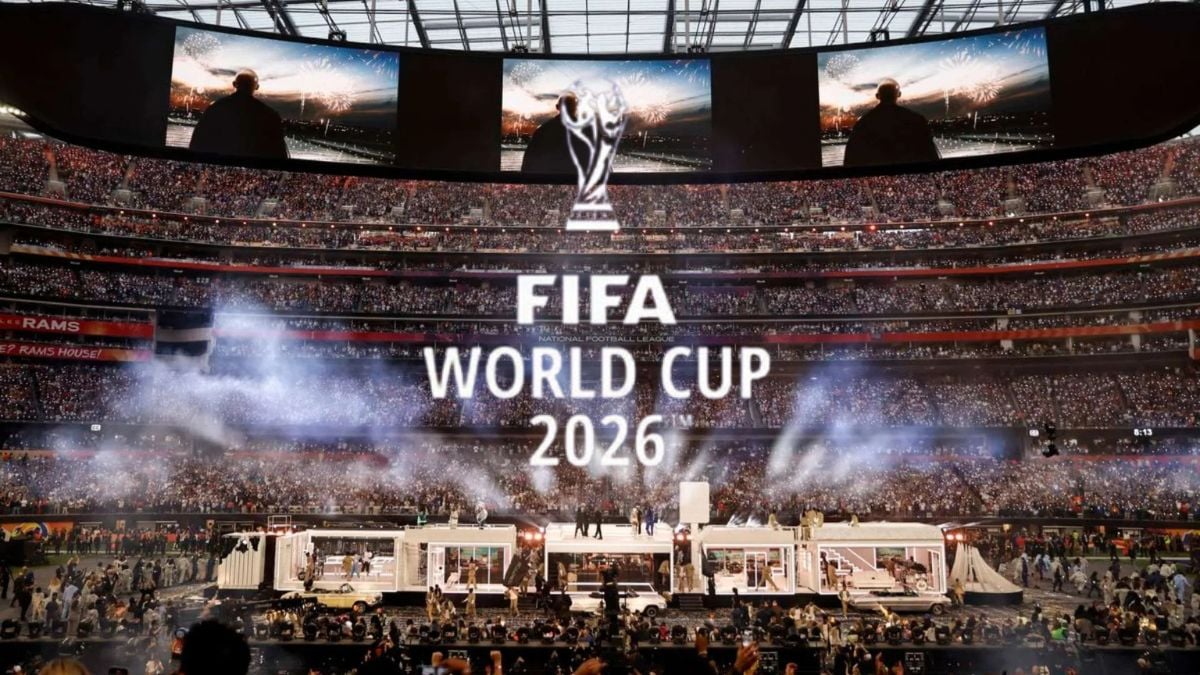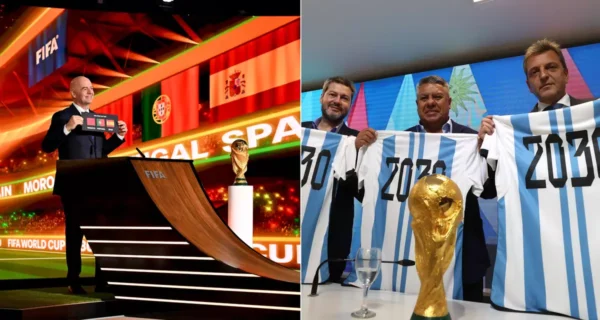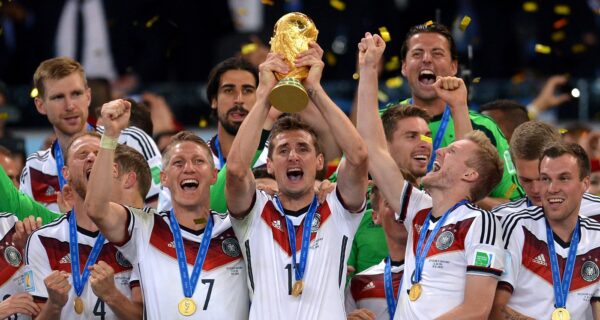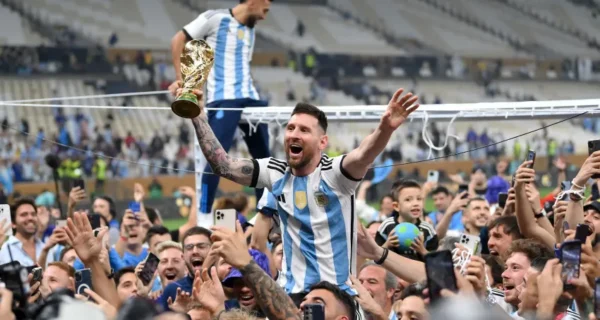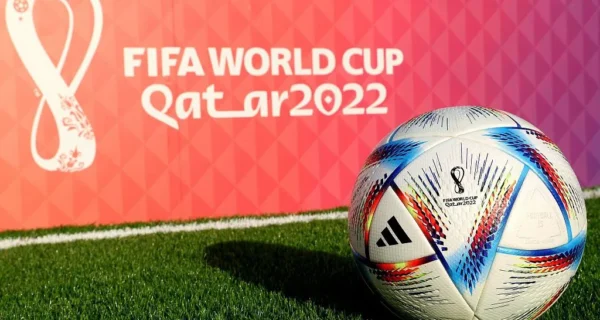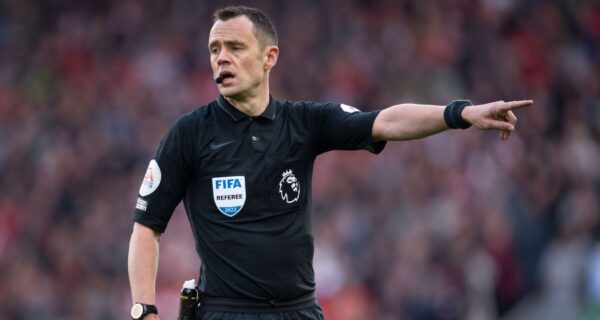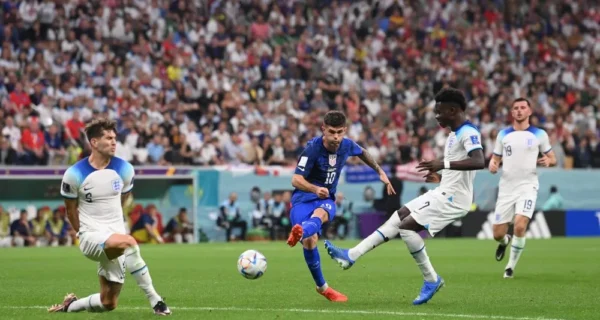This Article Contains
The 2026 FIFA World Cup will make history by featuring the first-ever halftime show during its final match. This groundbreaking addition to the world’s most-watched sporting event promises to blend international football with spectacular entertainment on an unprecedented scale.
FIFA President Gianni Infantino recently announced this exciting development, describing it as “a historic moment for the FIFA World Cup and a show befitting the biggest sporting event in the world.”
As football fans around the globe eagerly anticipate this landmark tournament co-hosted by the United States, Canada, and Mexico, the addition of a Super Bowl-style halftime performance raises the entertainment stakes significantly.
Let’s explore everything we know so far about this revolutionary fusion of sports and entertainment set to captivate billions of viewers worldwide.
The Historic Announcement
In March 2025, FIFA President Gianni Infantino made the official announcement via Instagram that the 2026 World Cup final would include a halftime show. This announcement marks a significant shift in World Cup tradition, as the tournament has never featured mid-game entertainment in its 96-year history.
The FIFA chief confirmed that the organization has partnered with international advocacy group Global Citizen to produce this groundbreaking spectacle.
The decision reflects FIFA’s ambition to expand the appeal of football’s premier tournament, particularly in the North American market where halftime shows have become cultural institutions through events like the Super Bowl.
By introducing this entertainment element, FIFA aims to attract new audiences and enhance the viewing experience for the estimated 2 billion people expected to watch the final match.
“The FIFA-Global Citizen halftime show will be a world first, a ground-breaking moment where sport, music and culture merge, celebrating football’s unique power to bring us all together,” explained Hugh Evans, CEO of Global Citizen, during the FIFA Commercial & Media Partners Convention in Dallas, Texas. This collaboration signals FIFA’s intent to create an entertainment experience that matches the global significance of the tournament itself.
Location and Timing Details
The historic first World Cup halftime show will take place at MetLife Stadium in New Jersey (temporarily renamed “New York New Jersey Stadium” for the tournament) on July 19, 2026. This venue, with a capacity of 82,500, will host the culmination of the expanded 48-team tournament that kicks off on June 11, 2026, in Mexico City’s iconic Estadio Azteca.
Unlike previous World Cup finals where the 15-minute halftime break focused solely on players resting and tactical discussions, the 2026 edition will transform this interval into a global entertainment spectacle. However, questions remain about how FIFA will manage the logistics of setting up and dismantling a large-scale performance within soccer’s traditional 15-minute halftime period. The Super Bowl, by comparison, extends its halftime to approximately 30 minutes to accommodate elaborate performances.
FIFA has not yet confirmed whether they’ll extend the halftime duration for the final match, leaving fans and analysts wondering how they’ll balance the entertainment needs with the sporting integrity of the competition. This logistical challenge represents one of the most interesting aspects of FIFA’s ambitious entertainment plans.
Coldplay’s Involvement in Artist Selection
A surprising element of FIFA’s announcement was the revelation that British rock band Coldplay will play a crucial role in curating the inaugural World Cup halftime show. Specifically, lead vocalist Chris Martin and the band’s manager Phil Harvey will collaborate with FIFA to finalize the list of artists who will perform during this historic event.
Coldplay brings valuable experience to this role, having headlined the Super Bowl 50 halftime show in 2016, where they shared the stage with Beyoncé and Bruno Mars. This performance background gives them firsthand insight into the unique demands and opportunities of a global sporting halftime show.
“I want to thank Chris Martin and Phil Harvey of Coldplay, who will be working with us at FIFA to finalize the list of artists who will perform during the halftime show, as well as at Times Square,” Infantino stated in his announcement.
The band’s involvement suggests FIFA intends to create a globally appealing music lineup that transcends cultural boundaries – fitting for a tournament that unites nations from across the world. Their participation also signals FIFA’s commitment to delivering a high-quality entertainment experience that meets international standards.
Potential Performers for the Inaugural Show
Even though official announcements about performers remain months away, speculation has already begun about which global artists might grace the first-ever World Cup halftime stage. Given the international nature of the tournament and its massive global audience, FIFA will likely aim for a diverse lineup of performers with worldwide appeal.
Several names have emerged as potential candidates based on their global popularity, previous involvement with sporting events, and international appeal. Sports Illustrated suggests Drake could be a strong contender, especially given his Canadian heritage and the tournament’s co-hosting by Canada.
His ongoing feud with Kendrick Lamar, who headlined the 2025 Super Bowl halftime show, adds an intriguing narrative dimension that could attract viewers.
Other possibilities include power couple Beyoncé and Jay-Z, whose global appeal and previous experience with major performances make them ideal candidates for such a momentous occasion. International superstars like Ed Sheeran and major DJs such as Calvin Harris or Diplo could also feature, bringing cross-cultural appeal to the performance.
Latin artists will likely play a prominent role given Mexico’s status as a co-host and the strong Latin influence in the North American music scene. Previous World Cup musical collaborators like Shakira, whose “Waka Waka” became an iconic World Cup anthem in 2010, might return to the World Cup stage in this new capacity.
The final lineup will need to balance regional representation, global appeal, and practical performance capabilities within the confines of a tightly scheduled halftime period.
The Times Square Takeover
Beyond the halftime show itself, FIFA has announced another ambitious entertainment initiative: a complete “takeover” of New York City’s iconic Times Square during the World Cup finals weekend. This supplementary event will transform one of the world’s most famous public spaces into a massive football celebration hub.
According to FIFA’s announcement, the Times Square activation will serve as a focal point for fans during both the third-place match (scheduled for July 18 in Miami) and the final itself on July 19. The area will feature live performances from “some of the world’s greatest music performers” along with public viewing areas for match broadcasts.
“Times Square will become the focus for fans outside during the FIFA World Cup finals weekend,” explained Infantino. “This is not only a watch party, as it will feature some of the world’s greatest music performers, live on stage, including four live crosses into the global broadcast of the bronze-medal match in Miami and the final itself to be seen by billions of people across the globe.”
This extension of the entertainment experience beyond the stadium reflects FIFA’s comprehensive approach to making the 2026 tournament a cultural event that transcends the matches themselves.
The Times Square event will allow fans without tickets to participate in the excitement and gives FIFA additional opportunities to showcase musical talent throughout the finals weekend.
Comparison to Super Bowl Halftime Shows
The introduction of a World Cup final halftime show naturally invites comparisons to the NFL’s Super Bowl halftime performances, which have become cultural phenomena in their own right. Understanding these parallels helps contextualize FIFA’s ambitions for this new entertainment format.
Super Bowl halftime shows typically last around 13-15 minutes of actual performance time, though the NFL allocates approximately 30 minutes total to accommodate the complex staging requirements. Recent performers like Kendrick Lamar (2025) attracted record viewership of 133.5 million across the United States alone.
By comparison, the 2022 World Cup final drew approximately 1.5 billion viewers globally, suggesting the potential audience for the 2026 halftime show could be exponentially larger than even the most-watched Super Bowl performances.
The Super Bowl has featured legendary artists including Michael Jackson, Prince, Beyoncé, and U2, with performances that became iconic cultural moments transcending the sport itself. Many viewers tune in specifically for these performances rather than the game, a phenomenon FIFA likely hopes to replicate on a global scale.
A key difference, however, lies in the logistical constraints. Football (soccer) traditionally maintains a strict 15-minute halftime, raising questions about how FIFA will manage the complex staging requirements without disrupting the sporting event. This timing challenge represents one of the most significant hurdles for FIFA to overcome in adapting the halftime show concept to the World Cup format.
FAQs
1. Who will perform at the 2026 FIFA World Cup halftime show?
FIFA has not yet announced specific performers for the show. However, Coldplay’s Chris Martin and Phil Harvey will help select the artists. Speculation includes major international stars like Drake, Beyoncé, Jay-Z, and Ed Sheeran, among others.
2. How long will the World Cup halftime show last?
The standard halftime in football matches lasts 15 minutes. FIFA has not confirmed whether they’ll extend this period for the final. By comparison, Super Bowl halftime shows typically get around 30 minutes total to accommodate setup and performance time.
3. When and where will the 2026 World Cup final and halftime show take place?
The final match and halftime show will occur on July 19, 2026, at MetLife Stadium (renamed “New York New Jersey Stadium” for the tournament) in East Rutherford, New Jersey, with a capacity of 82,500 spectators.
4. How will FIFA manage the logistics of setting up a show during the halftime break?
FIFA hasn’t detailed their logistical plans yet. This represents one of the biggest challenges, as they’ll need to quickly assemble and dismantle a major production while ensuring players have adequate warm-up time and space before the second half.
5. Why is FIFA adding a halftime show to the World Cup final?
FIFA aims to enhance the entertainment value of the tournament, attract new audiences, create additional commercial opportunities, and adapt to North American entertainment traditions where the tournament will be hosted in 2026.
6. What role will Coldplay play in the 2026 World Cup halftime show?
Coldplay will not necessarily perform themselves. Instead, lead vocalist Chris Martin and manager Phil Harvey will help FIFA curate the list of artists who will perform during both the halftime show and at Times Square events during finals weekend.
7. Will there be other entertainment events during the 2026 World Cup beyond the halftime show?
Yes, FIFA has announced a “takeover” of Times Square in New York City during the finals weekend, featuring live performances and public viewing areas for both the third-place match and the final game broadcast.
8. How many people are expected to watch the 2026 World Cup final and halftime show?
FIFA and Global Citizen are targeting an audience of approximately 2 billion viewers worldwide, which would make it one of the most-watched live broadcast events in history, far exceeding Super Bowl viewership.
9. How does the World Cup halftime show compare to the Super Bowl halftime show?
The World Cup final has a significantly larger global audience than the Super Bowl. However, the Super Bowl allocates more time (around 30 minutes) for its halftime show, compared to football’s traditional 15-minute break, creating different production challenges.
10. What has been the reaction to FIFA’s announcement of a World Cup halftime show?
Reactions have been mixed. Some traditional fans worry about commercialization and logistical disruptions to the match, others welcome the innovation as a way to enhance the event’s entertainment value and attract new audiences to football.

